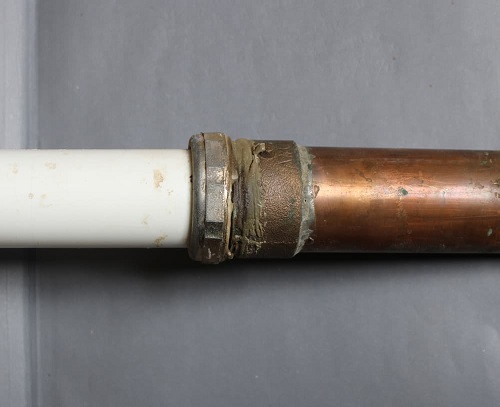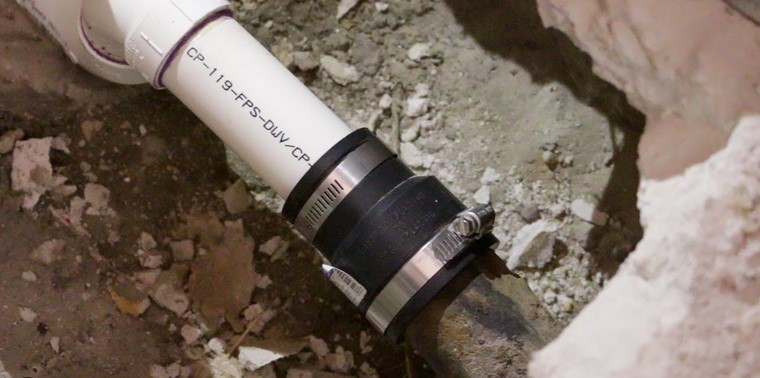Connecting pipes with different styles and sizes can be quite confusing initially. You can always leave this for your plumber who can do this in a jiffy. However, with a simple guide, you can do it too.
So, how to connect metal pipes to PVC? Obviously, you can’t use glue to connect your pipes, they will just cause further damage. What you need is threaded connectors. There are a bunch of different types of connectors with which you have to be specific. Use a metal female thread and a plastic male thread to connect the pipes.
Keep reading as we will give you a straightforward guide to help you connect the pipes. Moreover, we will tell you more about threaded connectors to avoid any confusion.
How to Connect Metal Pipes to PVC – Step-by-Step Guide
Before starting, you need to keep two things in mind.
- Firstly, PVC is usually larger than metal pipes, so measure them precisely to make them fit.
- The second thing is the quality of the pipes you’re buying. Low-quality metal pipes can easily rust in a short period of time.
If you have these two things cleared out, we can get to the actual step-by-step guide now.
Step 1: Cut your pipes
Cut the pipes according to the length you need. Also, make sure to take a little extra length, in case you make any errors. To make your pipe connections tight, use a hand saw or miter saw.
Use a wrench afterward to tighten the ends of your pipes for a better fitting.
Step 2: Connect the two pipes
Join the PVC with the metal pipe using a threaded connector. This is a crucial step so take as much time as you need.
Make sure the pipes are threaded into each other tightly to prevent leakage. This can be done easily with a wrench or socket tool with open ends.
Step 3: Use a sealer/ lubricant
After you’ve made sure your threaded connectors are tight enough, use a sealant/lubricant. Apply it on both ends of your connection points with a paintbrush or brush applicator. Don’t leave the connectors for too long without applying the sealant as they may rust
Once the sealant is applied, use some epoxy glue along the edges of the pipes and press them together. Wait for at least 30 minutes to let it all dry before moving on to the next step.
Step 4: Use Teflon tapes
Teflon tapes will not only prevent your pipes from being damaged but also act as a waterproofing method. They also keep the pipes from leaking. You can also use Teflon pipe or PTFE tape, they work just as well.
Most professionals prefer to use Teflon pipes as they require less time compared to Teflon tapes. However, if you’re not an expert, it’s completely fine to use whatever you want. Although, for sprinkler systems, you should strictly use Teflon or PTFE tape
Whatever you use, if your tape is of good quality, you will only need about 3-4 wraps around the threads. Don’t stretch it too much, just enough to see the shape of the threads through the tape

Use Threaded Connectors For Durability
Now that we’ve given you a simple guide on how to connect metal pipes to PVC, let’s get into details. Plastic male threads are used to connect metal female threads. If you do otherwise, your pipes will either break or leak. Let’s give you the reasoning behind it for a proper understanding of the threads.
The threads get tighter as you keep screwing them together to join the pipes. This happens because the threads will compress and stretch. However, if you screw the threads of two different materials, only the threads of the softer material will do all of the stretching or compressing.
If we connect a male metal thread with a female thread, the female thread is forced to stretch as it’s softer. This will cause the female plastic thread to crack and leak. Hence, female metal threads and male plastic threads are connected.
Retrofitting Water Pipes
If you’re transitioning to new pipes, more specifically to PVC or CPVC, start at a female threaded connector. This could be at a tee, coupling, or elbow. This allows you to screw in a PVC or CPVC male slip adapter with male threads and smooth socks on each end.
Female slip adapters crack easily when you tighten them onto a metal. So, to prevent needless repairs in the future, always use a male slip adapter. If you have to start from a male-threaded connector, use a galvanized coupling.
The galvanized coupling will create a connection with the female thread before transitioning to PVC. However, we recommend sticking to the female threaded connector when starting.
How To Connect Metal Pipes and PVC for Drain Pipes?
For drain pipes, you will have to do things slightly differently but it’s not too complicated. One advantage of drain pipes is that the water pressure in them is so low that the chances of leakage are absolutely low. So what exactly do you have to do differently?
- If you have to fix a section in the middle of the pipe, you can do so without re-threading the whole pipe.
- Cut the section that’s needed as straight as possible.
- Use a flexible connector with a precise diameter to create a pressure seal.
- Connectors that are made of rubbers and have clamps on each side are the best. The clamps allow you to easily tighten the connectors with a screwdriver.
Note: don’t ever just use glue for connecting the pipes.
Plastic Pipes vs Metal pipes
It’s always beneficial to know about the advantages and disadvantages of the materials you’re using. This will help you to identify what to use and when to use it, depending on the situation you are in.
Advantages of metal pipes
- Metal pipes are extremely long-lasting and durable
- They can withstand higher temperatures and pressure
- The chances of metal pipes cracking or leaking are low compared to plastic pipes
- Metal pipes can be recycled so they’re more eco-friendly
Disadvantages of metal pipes
- Metals corrode easily that causes rusty tap water
- More expensive compared to other materials
Advantages of Plastic pipes
- Plastic pipes are easier to work with
- They are more affordable compared to other materials
- They are lighter which makes them easy to transport and install
- They do not rust or corrode over time
- They provide insulation against heat loss
- They have a high tolerance towards the chemicals used in drain pipes
Disadvantages of Plastic pipes
- Plastic pipes aren’t as durable as the metal ones
- They can’t withstand higher temperatures and sometimes high pressure too
- They are more brittle and fragile when impacted
Frequently-Asked Questions
If you still have some further askings left, have your eyes here.
Q: What is the best glue for connecting metal pipes to PVC?
Epoxy adhesives are the best as they are water, heat, and impact resistant. They can work on all sorts of surfaces. You can also use silicone adhesives as they are quite durable and strong.
Q: Can you glue a PVC to another?
Yes, this can be done but you would need a specific primer and cement for this. Regular adhesives don’t tend to work for joining a pipe to another.
Q: Can I connect a corrugated metal pipe to PVC?
Connecting corrugated pipes to PVC isn’t as easy as connecting other pipes. However, with a utility knife and other regular tools, you can do it too with a bit of patience
Conclusion
If you’re confused about changing your pipes on your own, we suggest you go for it. However, before starting, get the correct tools and knowledge regarding the subject. Make sure you have the connectors specific to the pipes you’re changing and never skip out on the Teflon tapes and the sealants.
However, if you get stuck anywhere, you can always take a second glance at a simple guide on how to connect metal pipes to PVC. We hope this has been helpful and given you the boost of confidence needed to connect the pipes. So good luck!

